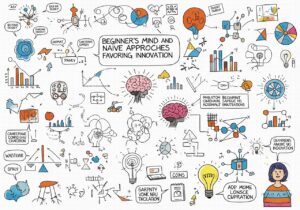Innovation often blooms in unexpected mindsets, as exemplified by George Dantzig’s remarkable experience with two statistics problems famously deemed unsolvable in his time. When Dantzig mistakenly submitted solutions to these “impossible” homework assignments, he unknowingly altered the trajectory of statistical research and later the simplex algorithm. This episode underscores a profound truth: our perceptions can shape the limits of our capabilities. A 2018 study found that individuals with a “beginner’s mind” approach are 25% more likely to achieve creative breakthroughs (Kahn & Gülşen, 2018).
By examining the psychological underpinnings of Dantzig’s success and the broader implications for innovation management, this article will elucidate how reframing challenges can dismantle self-imposed barriers and spark extraordinary solutions in engineering and product design.
Punti Chiave

- Due famosi problemi statistici irrisolti erano compiti sbagliati.
- George Dantzig li considerava semplicemente come incarichi più difficili.
- Una mentalità priva di limiti può portare a dei progressi.
- Il punto di vista di un principiante può ispirare soluzioni innovative.
- Il superamento delle barriere mentali migliora le capacità di risoluzione dei problemi.
L'aneddoto di George Dantzig

La storia
L'incontro di George Dantzig con un problema apparentemente impossibile iniziò nel 1939, mentre era studente universitario presso l'Università della California, a Berkeley. Una sera arrivò in ritardo a lezione e credette erroneamente che gli fossero stati assegnati due difficili problemi per casa. Questi problemi erano, a sua insaputa, sfide irrisolte di fama mondiale nel campo della statistica. Per Dantzig, essi apparivano semplicemente come una serie di esercizi ordinari in attesa di essere risolti, il che indirizzò la sua attenzione verso la ricerca di soluzioni piuttosto che soccombere a qualsiasi limite preconcetto associato alla loro difficoltà.
Dantzig ha lavorato diligentemente su questi problemi per diversi giorni, applicando le sue conoscenze di programmazione lineare. Al termine, ha presentato le sue soluzioni, che inizialmente sono state considerate come un semplice compito di laurea. È stato solo dopo che il professore di Dantzig, Jerzy Neyman, si è reso conto dell'importanza di questi "problemi a casa" che è stato riconosciuto il vero peso del risultato ottenuto da Dantzig.
Questo aneddoto illustra una profonda verità sulla cognizione umana: Dantzig ha affrontato il problema senza le catene della conoscenza preliminare della sua impossibilità. La sua ignoranza delle sfide prevalenti gli ha permesso di impiegare un ragionamento creativo e un pensiero strategico, parallelo agli elementi evidenziati nelle teorie psicologiche... e nel genio della matematica.
L'eccellente film "Good Will Hunting" (1997) di Gus Van Sant, si ispira a questo aneddoto come punto di partenza per svelare le capacità di Will Hunting (Matt Damon).
[embedyt] https://www.youtube.com/watch?v=-ViPmcdlfbQ[/embedyt]
Mancia: Quando si affrontano le sfide, mantenere una mentalità libera da limitazioni può produrre soluzioni inaspettate. Incoraggiate sessioni di brainstorming di gruppo in cui i partecipanti sono invitati a ignorare qualsiasi barriera presupposta, promuovendo un ambiente favorevole al pensiero innovativo.
Problemi irrisolvibili nel XX secolo

Il problema di Monty Hall presenta uno scenario in cui un concorrente partecipa a un gioco a premi e gli viene chiesto di scegliere una delle tre porte. Dietro una di queste porte c'è un premio di valore, come un'automobile, mentre dietro le altre due porte ci sono "capre" o non premi. Dopo che il concorrente ha fatto la sua scelta iniziale, il conduttore, Monty Hall, che conosce la posizione del premio, apre una delle altre due porte per rivelare una capra. La domanda centrale che viene posta al concorrente è: deve mantenere la sua scelta iniziale o passare all'altra porta rimasta aperta?
In the early 20th century, maths statistics faced numerous challenges, particularly with the conception of problems deemed unsolvable. Math focus was raising and statistics were were under-researched domains yet and compounded by a lack of advanced computing tools, limiting the ability to validate outcomes or engage in simulations that could clarify the inherent complexities of problems.
Una caratteristica significativa di questi problemi irrisolvibili era la loro dipendenza dalla comprensione dei limiti associati alla teoria delle probabilità e ai test di ipotesi.
On a non-pro level, cases like the famous “Monty Hall problem” showcased how intuition often led to incorrect assumptions:
Adottare la mentalità del principiante per l'innovazione
Esaminando l'ambiente aziendale, le organizzazioni che promuovono una cultura della sperimentazione e dell'assunzione di rischi spesso superano i loro concorrenti. Tali culture attraggono talenti e alimentano il pensiero innovativo.

- Una mente da principiante e approcci ingenui favoriscono l'innovazione consentendo nuove prospettive di risoluzione dei problemi.
- Engineers often view challenges through established norms, which can limit creativity and innovation.
- Riconoscere il valore di una mentalità da principiante aiuta gli individui a sganciarsi da nozioni preconcette, facilitando nuove intuizioni.
- Una mentalità libera da limitazioni percepite incoraggia la creatività e la resilienza.
- Le organizzazioni che coltivano una cultura della sperimentazione e dell'assunzione di rischi tendono a superare i concorrenti e ad attrarre talenti.
Mancia: Incoraggiare i team ad affrontare le sfide come esperimenti, piuttosto che come problemi, può sbloccare soluzioni innovative senza i limiti del pensiero tradizionale.
Mancia: Quando affrontate una sfida, chiedetevi se i limiti percepiti sono universalmente accettati. Considerate la possibilità di rivalutare il problema senza preconcetti sulla sua difficoltà.
Mancia: incoraggiare sessioni di brainstorming in cui i partecipanti sono invitati a proporre idee "folli" senza la pressione della fattibilità. Questo può portare a scoperte innovative, poiché suggerimenti apparentemente impraticabili possono ispirare soluzioni pratiche quando vengono ulteriormente perfezionati. Coltivare una cultura che premia l'innovazione, indipendentemente dalla sua origine, può portare a scoperte inaspettate.
La mentalità del principiante in un contesto di problem solving:
| Criteri | Approccio tradizionale | Approccio mentale del principiante |
|---|---|---|
| Creatività | Limitato dalle strutture esistenti | Incoraggia il libero pensiero e l'esplorazione |
| Identificazione del problema | Si basa su problemi noti | Aperti a scoprire nuove sfide |
| Generazione di soluzioni | Miglioramenti incrementali | Innovazioni radicali |
| Propensione al rischio | Avversione al rischio | Disposti a sperimentare e a fallire |

Superare i limiti autoimposti: Le limitazioni autoimposte spesso derivano da idee preconcette sulla fattibilità di alcuni problemi. Questa barriera psicologica può impedire ai team di tentare soluzioni radicali. Un approccio proattivo consiste nel coltivare un ambiente che incoraggi a porre domande "e se". Prospettive e competenze diverse possono rivelare aspetti trascurati di un problema e ispirare soluzioni innovative. In particolare, aziende come Google utilizzano la metodologia "20% time" o "1 giorno a settimana", consentendo agli ingegneri di dedicare una parte della loro settimana lavorativa a progetti collaterali.
Documentare le lezioni apprese: una valutazione sistematica dei progetti passati può evidenziare temi o schemi comuni nel successo e nel fallimento della soluzione dei problemi. Documentando le "lezioni apprese", le organizzazioni possono interrompere i cicli di inefficacia. Per esempio, le aziende che analizzano il feedback dei clienti migliorano ripetutamente i loro prodotti, individuando le esigenze degli utenti che potrebbero essere state trascurate in precedenza. Queste pratiche riflessive creano un ciclo di feedback che incoraggia il miglioramento continuo e la flessibilità dell'approccio, smantellando le barriere autoimposte all'innovazione.
Mancia:incorporano sessioni strutturate di brainstorming che sfidano i partecipanti a considerare soluzioni radicali, senza che nessuna idea sia troppo stravagante. Impostazione...
Avete letto 65% dell'articolo. Il resto è per la nostra comunità. Sei già un membro? Accedi
(e anche per proteggere i nostri contenuti originali dai bot di scraping)
Comunità Innovazione.mondo
Accedi o registrati (100% free)
Visualizza il resto di questo articolo e tutti i contenuti e gli strumenti riservati ai soci.
Solo veri ingegneri, produttori, designer, professionisti del marketing.
Nessun bot, nessun hater, nessuno spammer.































Adottare una mentalità da principianti è più facile a dirsi che a farsi, soprattutto in un mondo aziendale ad alta pressione?
In effetti, ma tutto ciò che vale non è forse una sfida? Accogliete la pressione e adattatevi!
Mai sentito parlare di Dantzig in questo modo. innovazione?